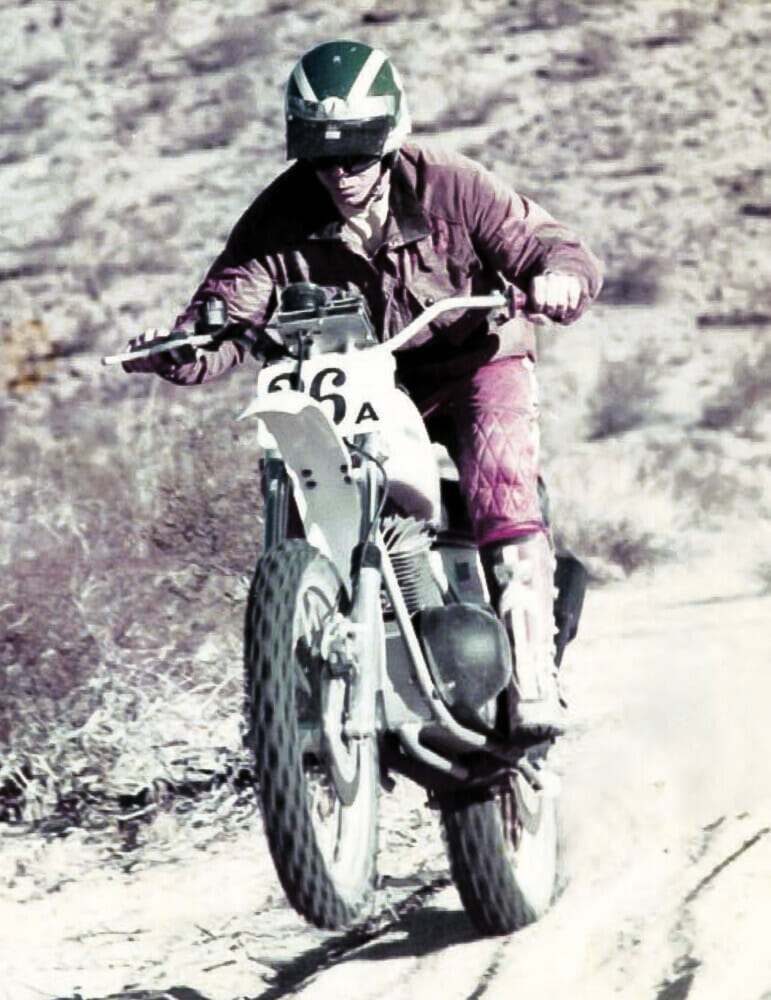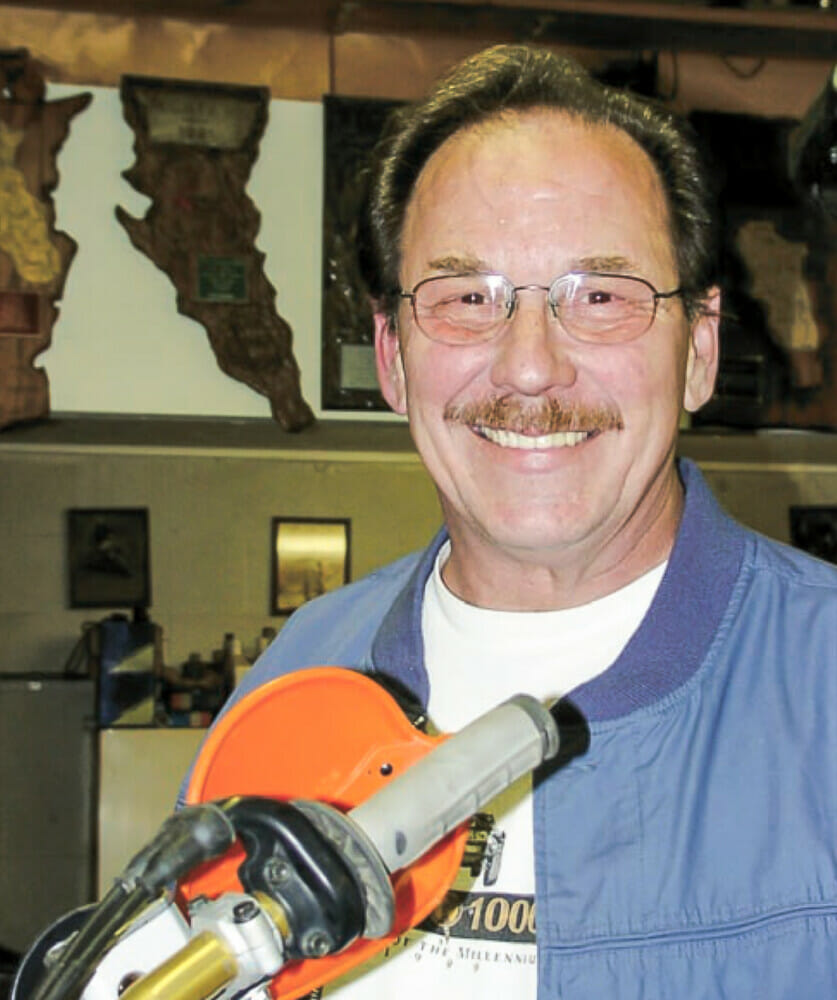Larry Lawrence | April 3, 2022
Cycle News Archives
COLUMN
This Cycle News Archives Column is reprinted from the September 23, 2009 issue. CN has hundreds of past Archives columns in our files, too many destined to be archives themselves. So, to prevent that from happening, in the future, we will be revisiting past Archives articles while still planning to keep fresh ones coming down the road -Editor.
The Bishop of Baja
Something happened at the Baja 1000 last year [2008] that didn’t draw much attention but was significant, nevertheless. Motorcycle Hall of Famer Ron Bishop, the only motorcycle racer to have competed in all 40 Baja 1000s, missed his first race ever. It marked the end of one of the most impressive streaks in all of motorcycle racing.
“I had a team together,” Bishop explained. “And at the last minute, things fell apart. I had some offers to ride with other teams, but it was so late in the game that I just decided to sit it out.”
 Ron Bishop was a top all-around off-road racer in the 1960s through ’80s and competed in every Baja 1000 race from 1967 to 2007.
Ron Bishop was a top all-around off-road racer in the 1960s through ’80s and competed in every Baja 1000 race from 1967 to 2007.
Over the years Bishop became one of the true legends in long distance off-road races such as the famous Baja 1000. Bishop raced every Baja 1000 from its start in 1967 to 2007. He won numerous class titles in many of the major off-road motorcycle races of the 1960s through the early 2000s, including the Baja 1000, Baja 500, Tecate 500, Mint 400 and Mexicali 300.
During the mid-1970s Bishop was also a two-time member of the American team in the International Six-Day Trials (ISDT, now called ISDE). Bishop was a factory off-road racer for Kawasaki and later Rokon.
Bishop was born in Woodland, Washington, March of 1943. His family moved to Southern California when he was 10 and settled in Escondido, a town in San Diego’s north county. The area was a hotbed of off-road motorcycling and most of Bishop’s friends had motorcycles. Bishop’s first ride was a Cushman Eagle scooter, which he naturally took off-road. He rapidly moved from the scooter to a Mustang and eventually to what Bishop called his first real motorcycle—a Zundapp 250cc Super Sabre.
In 1960, Bishop began racing scrambles and TT races.
“I’d race a TT every Friday night at Cajon Speedway in El Cajon,” Bishop recalled. “Then I’d put knobbies on the bike and go scrambles racing that weekend.”
Bishop learned from watching some of the San Diego area’s top riders, such as Cal Rayborn and Ralph White. While Bishop enjoyed racing TT and scrambles, he found the waiting around between races to be excruciating.
“You’d race, then sit around for hours until you got to race again,” Bishop remembers. But in enduros, hare scrambles and long-distance desert races, Bishop found his calling. In those events, there was no waiting around, just hours of wide-open racing.
Bishop rode many of the major off-road races of his era. The Greenhorn Enduro, Barstow to Vegas, and the grueling long-distance races such as the Mint 400 and the Baja 1000. Bishop became one of the leading off-road racers on the West Coast, but he wanted to prove himself among the best in the country. In the early to mid-1970s, the opportunity to show his skills outside of the West came in the form of ISDT qualifiers held throughout the country. Bishop earned a factory Kawasaki ride in 1973. It was a plush life compared to the normally low-dollar standards of off-road racers. Bishop flew to the races, stayed in nice hotels and had mechanics looking after his motorcycles. Off-road racing legend Walt Axthelm was the team’s manager.
Bishop, who grew up on the hard-packed, dusty and wide-open trails of Southern California, learned to ride in the tight trees, loamy dirt and often muddy conditions of the East Coast races, making him one of the most versatile off-roaders of his era.
He qualified for the 1973 ISDT—which was the first time it was held in the United States—in the scenic Berkshire Mountains in western Massachusetts. Unfortunately, Bishop’s (and all the other factory Kawasakis) experienced gearbox failures in the international competition and he did not finish the race.
Even though his first ISDT outing wasn’t a success on the track, Bishop still very much enjoyed the experience. He came back and qualified again for the ISDT in 1975, riding for the factory Rokon squad. That year, the prestigious weeklong event was held on the Isle of Man. Halfway through that year’s race, Bishop suffered a hard crash and broke ribs, once again, putting him out of the race. Nevertheless, Bishop later said that representing his country in two ISDT appearances was among the most memorable episodes of his racing career.
Being a factory Rokon rider gave Bishop a great insight on one of the most unique off-road racing motorcycles in the history of the sport. Rokons featured automatic transmissions. Bishop recalls the special riding techniques that were needed to ride this unusual bike.
“The Rokon would freewheel down hills, so you had to go against your instincts and give it throttle to actually control the back end of the bike,” Bishop said. “It had a snowmobile-style drive. One good thing about it was you couldn’t kill the engine. If you fell off the thing it would just lie there and idle. Going up hills, if the rear tire started to break loose it would just gear up until it quit spinning. It was a great concept, but it was probably 60 pounds heavier than other bikes of that era, and that extra weight would wear on you.”
The Baja 1000 first ran in 1967 and quickly became one of the best-known off-road races in the world. Over the years, Bishop became a legend in the race for competing in every Baja 1000 from its start in 1967 through the early 2000s. His best result in the race was overall runner-up in 1972 with co-rider Don Bohannon. The two of them rode a highly modified Suzuki TM400.
“In the early days of Baja, it was just you and a co-rider,” Bishops explains, as he shows a photo of himself in an early race wearing a military canteen, black leather riding pants and lineman boots. “The event has become so complex that in the 2001 race, our team consisted of 37 crew members and 13 support vehicles, along with all the GPS systems and high-tech communications gear. It’s really something.”
By the 2000s, the average speed of the race nearly doubled from the time Bishop first raced Baja in the 1960s.
Bishop described in vivid detail the tricks your mind would play on you after 14 hours on the bike riding at night.
“You would start to hallucinate from fatigue,” he said. “Cactus looked like they were moving, and you began hoping that the boulders, which started looking like houses, were the final checkpoint.”
During his years of off-road racing, Bishop became a self-taught electrical engineer of sorts and began developing more powerful lighting for his motorcycles. He was the first to figure out how to power halogen lights on his bikes. He earned such a reputation for his electrical and lighting systems that he worked for several factories over the years supplying them with bright and reliable lighting for high-speed racing in the dark desert.
 Bishops still operates Ron Bishop Motorcycles in San Diego.
Bishops still operates Ron Bishop Motorcycles in San Diego.
In the early 1980s, Bishop opened his own motorcycle shop, Ron Bishop Motorcycles, dealing exclusively in off-road motorcycles. Through his shop, Bishop worked with many of the leading off-road and motocross riders of the greater San Diego area from the 1980s to present day. The shop walls are adorned with trophies, photographs and vintage motorcycle parts, representing neatly 50 years of off-road racing history. It’s a place where off-road legends like Scot Harden, Tim Morton, Jimmy Lewis or Larry Roeseler might stop in to shoot the breeze. If you’re ever in the San Diego area and want to meet a living legend, you might want to visit. CN